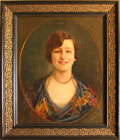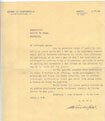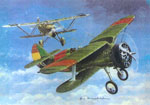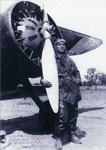|
|
| INTERESTING FACTS AND EVENTS. |
| |
|
On
this page we will attempt to reveal another facet of Carlos de Haya:
his waggish and curious side. A collection of texts and photographs
show how he attempted to discover other specialised skills deviating
from conventional aviation but without abandoning the key elements of
flying: the sky and the air. Take, for example, his interest in
parachuting, his keenness to experiment with other inventions, such as
the seagull glider, or to fly in a hot-air balloon…
|
 |
Mandolin belonging to Carlos Haya since his time as a cadet. |
 |
Charcoal drawing made by Carlos de Haya in
1922 in Africa. |
 |
Ceramic portrait of M. Amann made by Carlos de Haya in 1924 (aged 22). |
 |
Oil of her sister Lolita painted by Carlos de Haya in 1927. |
 |
Stamp
commemorating Carlos de Haya. |
 |
First
graduation of paratroopers. Back row standing (from left to right):
José Gamir Rubert, José Mendez Parada, Valeriano Turne Perez Deseoane,
Isidoro Lopez de Haro, Gonzalez Marcos, Luis Rambaud Goma. Front row
seated (from left to right): Angel Chamorro Garcia, Carlos de Haya
Gonzalez, Angel Pastor Velasco, Rafael Gomez Jordana Souza, Arturo
Alvarez Buylla. |
 |
Tetuan, 1927.
Tauler “the Terrible” and me with my Napier 66. |
 |
Carlos de Haya
flying under the Bilbao suspension bridge (1926). |
 |
Invitation from the German Air Force to a flight to South America in the Graff Zeppelin. |
 |
The
Tabalada Group 22, escorting the Graff Zeppelin on its flight over Baja
Andalucia. On board, the Prime Minister Lerroux and three of his
cabinet ministers. |
 |
Carlos de Haya
with parachute in 1927. |
 |
Carlos Haya
testing the sea glider “seagull” built by Cañete. |
 |
Reunion
at the Ritz Hotel in 1928. Seated in front row, from left to right:
(X), Carlos Masquelet Lacaci – 2nd in command of the M.A.-, Manuel
Nieves Couso – Head of the M.A.-, (X), Manuel Goded Llopis, (X), (X),
Second row: Senen Ordiales Gonzalez, Manuel Iglesias Brage, Pio
Fernandez Mulero, José Perez Pardo, Angel Fernandez de la Granda; Third
row: Cipriano Rodriguez Diaz, Alejandro Gomez Spencer, (X), (X), (X);
Back row: (X), (X), Julio Ruiz de Alda Migueleiz, Rafael Llorente Solá,
(X), Carlos de Haya Gonzalez, Francisco Leon Trejo, Martin Elviro
Berdeguer, Francisco Fernandez-Longoria Gonzalez, (X) Ignacio Jimenez
Martin. (The (X) marks those still unidentified). |
 |
Free
ascent as crew members of the balloon “Comandante Molas”, which lifted
in Guadalajara and landed in Benifar (Huesca) in 1929. In the picture
we can see it landing on an olive tree and the hand-written note of
Carlos de Haya himself, which reads: “’good’ landing with the aid of a
protective olive tree”. |
 |
The “Douglas” plane flown by Captain Haya, which was affectionately nicknamed “the Baker” (El Panadero). |
 |
Dropping provisions and medicines to supply the Santuario. |
 |
The moment of the collision between the Fiat CR-32 ‘Chirri’ piloted by Captain Carlos de Haya and the Polikarpov I-15 ‘Chato’ of Lieutenant Viñals, which resulted in the death of the former. |
 |
Lieutenant Viñals |
|
| Click on photo to
see image enlarged. |
|
| THE ORIGIN OF THE EMBLEM OF THE FIRST
GRADUATION CLASS OF THE AIR SERVICE CORPS. |
|
During
the siege of the Sanctuary of the Virgen de la Cabeza the Captain of
the Air Corps, Carlos de Haya, a true guardian angel of the besieged
troops, carried out nearly 90 supply missions in aid of the defending
soldiers, in different aeroplanes and often under the most adverse
conditions. For his selfless dedication to the mission and the
fearlessness shown during these flights, being hit by enemy fire on
numerous occasions, he received the maximum military award, the Laurel
Crowned Cross of San Fernando.
The
precarious means available at the initial stages of the war made it
necessary to think up ingenious ways of getting through supplies (so
essential but not as abundant as would have been wished) with safety
and precision, owing to the scarcity of aeroplanes that could not be
deferred from other war missions, as well as the insufficient number of
dropping mechanisms.
Captain Haya, in an effort to get the maximum
efficiency out of the supplies being transported to the Sanctuary,
devised a system that combined the maximum load of food and supplies
with the minimum amounts of elements and medicines required to
guarantee the safe dropping off of the aid packages. This idea
consisted of storing the lightweight loads in baskets which, tied to
the feet of live turkeys, softened the impact of the drop helped by the
wing flutter of the birds, thus rendering edible the “braking system”
employed.
Captain Haya had come from the service corps and therefore the 1st
Graduation Class of the Air Service Corps, proud of the feats of their
Corps predecessor and companion and wishing to honour his memory,
adopted as their graduation year emblem the one shown below, on account
of its peculiar origin and its notoriety.
|
|
|
| COMBATS BETWEEN CHATOS – FIATS. |
|
On
20th February 1938, Captain Carlos de Haya was called to take part in a
protection mission on the war Front and in a display of great
commitment and courage, he left his base a day after burying his
mother; thus, on 21st February 1938, after lunch, Squadron 11, 1-15
(Chatos) including a still emotionally affected Carlos de Haya,
departed for the Front on its mission of protection.
Later,
the events that took place that day would for some time after be
related as follows by his adversaries: “ Scarcely 30 minutes had passed
since the squadron had taken off when 2 cars arrived at the field
carrying several men accompanied by a Captain of the M.A. who told us
they were a supervisory committee. One and a quarter hours after the
take off, the squadron spied a single plane flying at a relatively low
altitude and which was heading in the direction of the field without a
fixed vertical plane and without a rudder. One of the members of the
committee shouted out “Tail-less plane! Tail-less plane!” The plane
landed with difficulty and the pilot, Manuel Orozco Roviro, explained
that a Fiat had crashed into him and he did not know what had happened
to it. The following day we found out from a Lieutenant of the Squadron
that according to the Nationalist radio station, in the combats between
Chatos and Fiats fought in the early afternoon of the previous day, in
which more than 50 planes had taken part with fatalities on both sides,
as a result of a crash with a fighter pilot, Carlos de Haya Gonzalez
had been killed.
One of the Chatos pilots was shocked when he heard
of Captain Haya’s death as he had been a pupil of his in the School of
Aviation Mechanics and Captain Haya had helped him a lot, giving him
books and flying with him in the training sessions of non-visibility
flight in the evenings in the countryside around Alcala de Henares.
|
| CARLOS DE HAYA, ADMIRED BY HIS SUPERIORS. |
|
In 1929 Commander Ramon Franco asked Carlos de
Haya to pilot a plane
for a long test flight. The merits of the young Carlos de Haya, in
spite of his youth, and above all his experience in night flying and
expertise were taken into account by the Commander, as can be inferred
from the following fragment of the book “Aguilas y Garras” (Eagles and
Claws) written by Commander Franco himself.
"…Taking
advantage of the May moon I wanted to make a test and resistance flight
and filling the ‘Dornier 15’ with 3,600 litres of fuel, Carlos Haya, a
highly skilled pilot and expert in night flying, the mechanic
Madariaga, and I, at two o’clock in the afternoon and after a smooth
take off, began our flight, which lasted until ten o’clock the
following morning, at which time we made a sea landing with about
twenty litres of petrol remaining in the tank.
Although
the Observatory had not foreseen it, from twelve o’clock midnight until
ten in the morning, it was pouring with rain and along the whole
coastline between Barcelona and Cartagena, under very difficult flying
conditions that put to the test our “Hispano” engines, in spite of the
vast amount of water around us, there was not a single mechanical
failure during the entire flight.
We
did
this several times along the coast between Los Alcazares and Barcelona
and between Los Alcazares and Alicante, flying at an average speed of
150 km/h and, towards the end, we circled Mar Menor, as the poor
visibility caused by the downpour made the flight dangerous. We
finished the test flying up and down the Mar Menor coastline sixteen
times.
After
this twenty hour flight, in which I was so ably assisted by the
extraordinary expertise of Carlos Haya, I refuelled the plane up to its
4,150 litre capacity, which extended the flight duration to twenty
three or twenty four hours and the flying range increased to 3,500
kilometres…"
|
| RUIZ
DE ALDA OFFERS CARLOS DE HAYA A
CAREER IN POLITICS |
|
When
Julio Ruiz de Alda, Haya’s co-pilot in the Dornier Plus Ultra for over
ten thousand kilometres and triumvirate member of the Falangist
movement, invited him a few months before the military uprising of 18th
July to devote his life to politics, Haya replied that he would not
abandon his profession as aviator for anything in the world.
|
| CARLOS DE HAYA’S FLYING TIME |
|
Before
the outbreak of the Spanish Civil War on 18th July 1936, Carlos de Haya
was the pilot with the most flying time in Spain – a total of 2,425
hours.
From 18th July
1936 to 21st February 1938 (the date of his death) he clocked up 760
hours of flight, bringing the total to 3,127 hours making Carlos de
Haya the pilot with the most flying time at that moment.
|
|
|
Until
18/07/1936
|
From
18/07/1936 to 21/02/1938
|
Total until 21/02/1938
|
|
Flying time
|
2425
|
760
|
3127
|
|
|
| MISSIONS TO THE SANCTUARY |
During
the siege of the Sanctuary of Nuestra Señora de la Cabeza (The Virgin
of the Head), the Captain of Aviation Carlos Haya, a genuine guardian
angel of the besieged, carried out nearly 90 air missions aiding and
supplying the defending forces, in different planes and frequently
under the most adverse of conditions, running up a total of 144 hours
and 23 minutes, all of which were voluntary and performed when off duty
(95% of these missions unescorted and 70% by night).
The
precarious means available at the beginning of the war made it
necessary to come up with inventive solutions to getting the supplies
(so necessary but not as abundant as one might have wished) to their
destination safely and with precision, owing to the lack of planes,
which could not be diverted from other war missions and to the
inadequacy of the air-drop mechanisms.
It was this same Captain
Haya who, in his determination to get the maximum amount of transported
supply material to the Sanctuary, came up with the idea for a system
which brought together the greatest amount of provisions with the
minimum number of items and medicines needed to guarantee the safety of
the dropped supplies. This idea consisted of packing the light supplies
in baskets which, tied to the legs of live turkeys, were absorbed
against the impact of the fall by the flapping wings of the fowls, thus
making the “breaking system” employed also edible.
Another
interesting anecdote about these Sanctuary missions tells of how on
occasions he would arrive with more than 40 hits in the fuselage and on
one particular day he returned with a hole measuring 57cm.
Another
story relates the origin of the nickname given to Captain Haya and his
plane by the small children in the Sanctuary who would joyously
shout “Here comes the Baker” every time they saw his plane on
the
horizon which also brought them comics bought by Jarén, the mechanic.
|
|
|
|
30th December 1936
|
2 trips, 3hrs 15mins.
|
|
31th December 1936
|
4 trips, 4hrs 58mins.
|
|
1st January 1937
|
1 trip, 1hrs 45mins.
|
|
18th January 1937
|
4 trips, 3hrs 12mins.
|
|
19th January 1937
|
4 trips, 4hrs 23mins. (all night
flights)
|
|
9th January 1937
|
3 trips, 6hrs 10mins.
|
|
TOTAL
|
86 voluntary missions, 144hrs 23mins.
|
|
This table shows an extract taken from Captain Haya’s flight log. On
some days he made 4 flights, which meant nearly 5 hours flying time. On
one particular day, carrying out 3 night missions, he clocked up 6
hours 10 minutes of flying time. Some flights, like those made on 31st
December, had to be aborted because of bad weather. In the next link
you will find a table containing all the data and events relating to
the supply missions and bombing campaigns against the forces besieging
the Sanctuary.
|
|
Table showing the Sanctuary missions
(Click to see table)
|
|
| THE FIRST DAYS OF THE WAR. |
|
When the Spanish Civil War broke out on 18th
July 1936, Captain de Haya was in Malaga (a Republican zone), where his
wife had just given birth to twin boys. He took a cargo-carrying vessel
at the port of Malaga (the “Navemar”), stopping just off the coast in
front of the beaches of Chipiona, which he reached by swimming. He
presented himself to the authorities and flew from Jerez to Seville in
a friend’s light aircraft where he placed himself at the command of
Queipo de Llano.
Some days later his wife was to be taken prisoner and was separated
from the care of her newly born twins, remaining in Malaga until the
Republican Governor abandoned the city and took her in his car to
Valencia along the Almeria coastal road and handed her over to Galarza.
She remained prisoner until she was exchanged for the Hungarian
reporter Arthur Koestler who was taken by Carlos de Haya himself in a
plane from Seville to Algeciras, whilst his wife was disembarking in
Gibraltar after the sea passage from Valencia. This exchange was made
possible by the intervention of the Red Cross.
The table below shows the flying time from the first war missions
carried out by Captain Haya following his move to Seville (the area of
the insurgents).
|
|
| 22nd July 1936 |
6hrs 18mins |
| 25th July 1936 |
5hrs 45mins |
|
26th July
1936
|
4hrs 55mins
|
|
27th July
1936
|
5hrs 23mins
|
|
28th July
1936
|
7hrs 47mins
|
|
29th July
1936
|
4hrs 32mins
|
|
30th July
1936
|
9hrs 14mins
|
|
31st July
1936
|
6hrs 27mins
|
|
TOTAL HOURS (FIRST 10 DAYS OF
MISSIONS)
|
50hrs 21mins
|
|
|
QUALIFICATIONS AND MERITS
OBTAINED BY CARLOS DE HAYA.
| 1921 |
Service Corps
Second Lieutenant. Second in his promotion. |
| 1925 |
Pilot |
| 1926 |
Hydroplane Pilot |
| 1926 |
Use Radiogoniómetro |
| 1927 |
Course in
Non-visibility navigation |
| 1927 |
Qualified First
Class Radio-telegraph operator |
| 1927 |
Instructor at the
School of Mechanics |
| 1927 |
Paratrooper course |
| 1928 |
Aeroplane observer |
| 1929 |
Free ascent as crew
member of aerostatic balloon |
| 1930 |
Sets three world
records |
| 1930 |
Flight from Seville
to Bata |
| 1931 |
Instructor for
non-visibility flight |
| 1934 |
Technical Aviation
Secretary (appointed by General Director of Aeronautics, General Goded) |
|
|
| SOME OPINIONS ABOUT
CARLOS DE HAYA. |
|
|
Emilio Herrera:
"There are few occasions on which an Aviation
Service officer can excel himself in the call of duty in the way
Captain Haya has done” (A. and A. journal March, issue nº 579, 1989).
Mendiola:
" In Tabalad I was assigned to the squadron
under the command of Vara de Rey. It was there I met Lieutenant Carlos
de Haya Gonzalez, my instructor for non-visibility flight. What I felt
for that officer was true affection and admiration”. (Journal
Aeroplano, issue Nº 17).
Ramón Franco:
" In Tabalad I was assigned to the squadron
under the command of Vara de Rey. It was there I met Lieutenant Carlos
de Haya Gonzalez, my instructor for non-visibility flight. What I felt
for that officer was true affection and admiration”. (Journal
Aeroplano, issue Nº 17).
José Jové:
"….he informed us of the death of Carlos Haya
and he realised that I was greatly moved for, according to his account,
tears welled up in my eyes and he judged me to be very sentimental. I
explained to him that from 1930 to 1933 all of us in the Aviation Corps
were a family and Haya was an instructor in School of Aviation
Mechanics who had helped me a lot. He gave me some books from that
School (which I still have) and I had flown with him on many occasions
on training flights, non-visibility flights, over the countryside
surrounding Alcalá de Henares at sunset.” (Extract from book by José
Jové).
Felix Igunza:
"He recalls some of the pupils who flew with
Carlos Haya, who were in general older than him, such as Commander
Botana, who was lame. Haya had come to fly to Cuatro Vientos and Igunza
was his assigned mechanic and accompanied the pilot on many flights and
trips. The pupils were continually taking it in turns, “one would get
off and another would get on board”, and consequently he flew a great
deal, without rest; according to his fervent comments “he was the
greatest aviator in Spain” (journal Aeroplano, 2004, issue nº 22)
Lacalle:
"I will confine myself to just one comment,
taken from a book written by one of his enemies.” So says Andrés García
Lacalle, prominent government pilot and fighter commander of the
Republican aviation during the war: “Captain Haya was, in my opinion,
the most complete pilot that Franco’s aviation had and for whom I felt
respect and admiration. I made a personal visit to see him in Bilbao,
at his house in the Gran Via, to ask him for his advice regarding
whether or not I ought to become a civil pilot so as to enlist on the
military pilot’s course later. And when I say that he was the most
complete pilot it is because he mastered all the specialised
theoretical and practical areas.”
Queipo del Llano:
"That bravest and most spirited of all brave
men; that good and modest man who was the extraordinary aviator Captain
Haya” (extract from book by Queipo de Llano).
A. Kindelán:
"For me the heroes of this period are
embodied in three symbolic names: Morato, Haya and Vázquez.”
Ruggero Bonomi:
"Spanish pilot captain Haya. A magnificent
fighter this Captain Haya….because Captain Haya does everything…he
transports troops, brings fresh supplies to the besieged, drops
propaganda newsletters, a highly skilled pilot, a fervent patriot.”
(Extract from book by Ruggero Bonomi).
Serguiei Abrósov:
The
battle of Teruel
Pages 207-208
According to a statement made
by the Republican pilots involved in the combat, 6 Messerschmitt and 4
Fiat planes were shot down. In Republican territory several Fiat were
found; one with a dead Spanish pilot, Captain Carosaya, known to be the
best pilot in Spain; the other – an Italian pilot who, after being
arrested, showed resistance and was killed; the Italian pilot of the
third plane was taken prisoner. The pilot shot down in this combat
“Captain Carosaya” was in fact called Carlos de Haya González and was
one of the best known pilots in
Spain, who contributed greatly to the process of development of
Franco’s air forces. In fact he did not often fly fighter planes, on
occasions his role was to act as personal pilot to Franco. To sum up,
González was able to carry out 760 aerial missions for the war, mainly
in the Breguet XIX, the S.M. 81 and the DC-2, and he clocked up 2,245
flying hours, a figure that was not surpassed in the civil war. Before
he died, he was flying in the Italian squadron Group 23 “Ace of Clubs”.
It was precisely this plane that Captain Carlos González was piloting
when, during this air combat, he collided with an I-15.
(*) Leningrad citizens in Spain 19(70) File nº
49. Log of war actions of the Republican air force, 1,138 – 31.12.3889
(*) Leningrad citizens in Spain 1989
(92) Leningrad 198
Translated and dispatched personally by José
María Bravo on 7/11/2009.
Capitán Cortés’ opinión (They never had the opportunity to meet):
"“Our most enthusiastic congratulations on the bravery of Capitán Haya, who in our most
desperate moments, we perceived in the skies, and watched as he came to our aid in the most unselfish manner. We extend our most sincere
gratitude, content in the hope that he is now happily reunited with his family, reportedly residing in Málaga” (From the book: La Epopeya del
Silencio de J.P. Cortés Camacho).
Extract from the text accompanying the award of Honour:
"…For the carrying out of missions that would
have exhausted not just one pilot but several.” He died at the age of
36 on the 21st February 1938 at 11.00 hours, twenty four hours after
attending the burial ceremony of his mother, for saving the life of a
fellow pilot who was being tailed.
|
|
|
|
|
|
|

